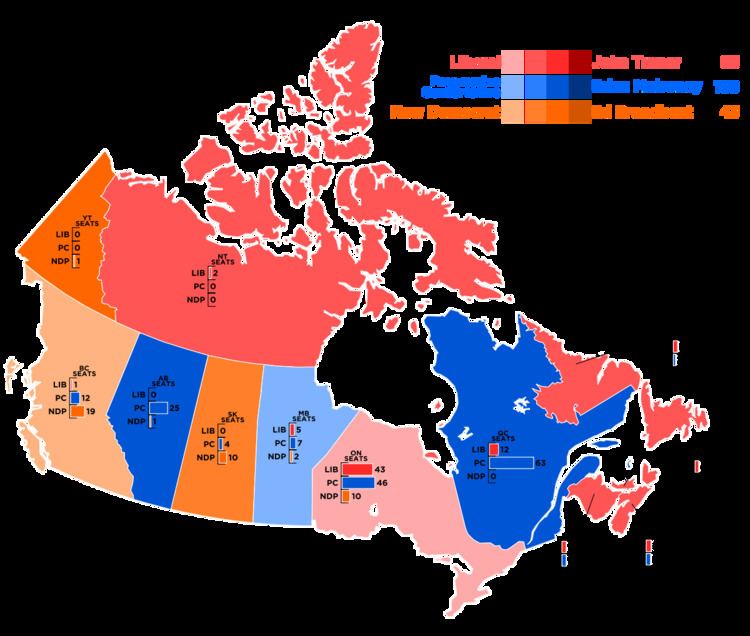November 21, 1988 1993 → 211 seats, 50.03% 40 seats, 28.02% 203 38 | Turnout 75.3% 40 seats, 28.02% 30 seats, 18.81% 38 32 | |
 | ||
The Canadian federal election of 1988 was held November 21, 1988, to elect members of the Canadian House of Commons of the 34th Parliament of Canada. It was an election largely fought on a single issue: the Canada-U.S. Free Trade Agreement (FTA).
Contents
Incumbent Prime Minister Brian Mulroney, leader of the Progressive Conservative Party, had signed the agreement. The Liberal Party, led by John Turner, was opposed to the agreement, as was the New Democratic Party led by Ed Broadbent.
The Conservatives went into the election suffering from a number of scandals. Despite winning a large majority only four years before, they looked vulnerable at the outset.
The Liberals had some early struggles, notably during one day in Montreal where three different costs were given for the proposed Liberal daycare program. The campaign was also hampered by a Canadian Broadcasting Corporation report that stated there was a movement in the backroom to replace Turner with Jean Chrétien, even though Turner had passed a leadership review in 1986.
Support swung back and forth between the Conservatives and Liberals over free trade. With mid-campaign polls suggesting a Liberal government, this prompted the Conservatives to stop the relatively calm campaign they had been running, and go with Allan Gregg's suggestion of "bombing the bridge" that joined anti-FTA voters and the Liberals: Turner's credibility. The ads focused on Turner's leadership struggles, and combined with over $6 million CAD in pro-FTA ads, managed to stop the Liberals' momentum.
The Liberals reaped most of the benefits of opposing the FTA and doubled their representation to 83 seats to emerge as the main opposition; the NDP had also made gains but finished a distant third with 43 seats. The Progressive Conservatives won a reduced but strong majority government with 169 seats. Despite the Liberals' improved standing, the results were considered a disappointment for Turner, after polls in mid-campaign predicted a Liberal government. The election loss sealed Turner's fate and he eventually resigned in 1990, and was succeeded by Jean Chrétien.
Although most Canadians voted for parties opposed to free trade, the Tories were returned with a majority government, and implemented the deal.
Until the 2011 federal election, the 1988 election was the most successful in the New Democratic Party's history. The party dominated in British Columbia and Saskatchewan, won significant support in Ontario and elected its first (and, until the 2008 election, only) member from Alberta.
This was the second election contested by the Green Party, and it saw a more than 50% increase in its vote, but it remained a minor party.
The election was the last for Canada's Social Credit movement: the party won no seats, and had an insignificant portion of the popular vote.
The newly founded Reform Party also contested the election, but was considered little more than a fringe group, and did not win any seats.
For the Progressive Conservatives, this was the last federal election they would win.
National results
For a complete list of MPs elected in the 1988 election see 34th Canadian Parliament.
Note:
"% change" refers to change from previous election
Vote and seat summaries
A number of unregistered parties also contested the election. The Western Canada Concept party, led by Doug Christie, fielded three candidates in British Columbia. The Western Independence Party ran one candidate in British Columbia, seven in Alberta, and three in Manitoba (although one of the Manitoba candidates appears to have withdrawn before election day).
The Liberal candidate in Etobicoke-Lakeshore, Emmanuel Feuerwerker, withdrew from the race after suffering a heart attack, resulting in the Liberals not running a candidate in all 295 ridings during this election.
The Marxist–Leninist Party fielded candidates in several ridings.
Blair T. Longley campaigned in British Columbia as a representative of the "Student Party". Newspaper reports indicate that this was simply a tax-avoidance scheme.
The moribund Social Credit Party actually fielded fewer candidates than was required for official recognition, but the Chief Electoral Officer allowed the party's name to appear on the ballot by virtue of its history as a recognized party.
Results by province
xx - less than 0.05% of the popular vote.
Note: Parties that captured less than 1% of the vote in a province are not recorded.
